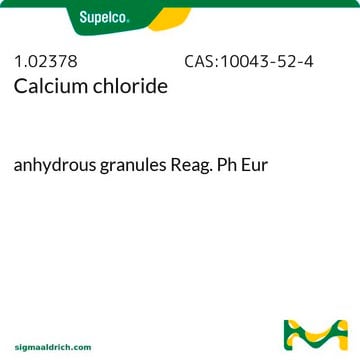Products may be shipped at a different temperature than the recommended long-term storage temperature. If the product quality is sensitive to short-term exposure to conditions other than the recommended long-term storage, it will be shipped on wet or dry-ice. If the product quality is NOT affected by short-term exposure to conditions other than the recommended long-term storage, it will be shipped at ambient temperature. As shipping routes are configured for minimum transit times, shipping at ambient temperature helps control shipping costs for our customers. For more information, please refer to the Storage and Transport Conditions document: https://www.sigmaaldrich.com/deepweb/assets/sigmaaldrich/marketing/global/documents/316/622/storage-transport-conditions-mk.pdf
Wichtige Dokumente
C5670
Calciumchlorid
anhydrous, BioReagent, suitable for insect cell culture, suitable for plant cell culture, ≥96.0%
Synonym(e):
CaCl2, Calcium dichloride
Größe auswählen
Größe auswählen
About This Item
Empfohlene Produkte
Qualität
anhydrous
Dampfdruck
0.01 mmHg ( 20 °C)
Produktlinie
BioReagent
Assay
≥96.0%
Form
powder
Methode(n)
cell culture | insect: suitable
cell culture | plant: suitable
mp (Schmelzpunkt)
772 °C (lit.)
SMILES String
[Cl-].[Cl-].[Ca++]
InChI
1S/Ca.2ClH/h;2*1H/q+2;;/p-2
InChIKey
UXVMQQNJUSDDNG-UHFFFAOYSA-L
Suchen Sie nach ähnlichen Produkten? Aufrufen Leitfaden zum Produktvergleich
Allgemeine Beschreibung
Anwendung
Transfektion von eukaryotischen Zellen entweder mit Plasmid-DNA oder genomischer DNA mit hohem Molekulargewicht verwendet. Die CaCl2-vermittelte Elektroporation von E. coli mit der Plasmid-DNA pBR322 wurde untersucht. Es wurde ein Protokoll für die Konzentration der Virusvektoren unter Verwendung von CaCl2 publiziert.
Angaben zur Herstellung
Signalwort
Warning
H-Sätze
Gefahreneinstufungen
Eye Irrit. 2
Lagerklassenschlüssel
13 - Non Combustible Solids
WGK
WGK 1
Flammpunkt (°F)
Not applicable
Flammpunkt (°C)
Not applicable
Hier finden Sie alle aktuellen Versionen:
Analysenzertifikate (COA)
Die passende Version wird nicht angezeigt?
Wenn Sie eine bestimmte Version benötigen, können Sie anhand der Lot- oder Chargennummer nach einem spezifischen Zertifikat suchen.
Besitzen Sie dieses Produkt bereits?
In der Dokumentenbibliothek finden Sie die Dokumentation zu den Produkten, die Sie kürzlich erworben haben.
Kunden haben sich ebenfalls angesehen
Artikel
Calcium is an ionically stable divalent cation with important beneficial and toxic properties in cell culture. It is a component of a wide range of cell culture media.
-
How is shipping temperature determined? And how is it related to the product storage temperature?
1 answer-
Helpful?
-
-
How can I determine the shelf life / expiration / retest date of this product?
1 answer-
If this product has an expiration or retest date, it will be shown on the Certificate of Analysis (COA, CofA). If there is no retest or expiration date listed on the product's COA, we do not have suitable stability data to determine a shelf life. For these products, the only date on the COA will be the release date; a retest, expiration, or use-by-date will not be displayed.
For all products, we recommend handling per defined conditions as printed in our product literature and website product descriptions. We recommend that products should be routinely inspected by customers to ensure they perform as expected.
For products without retest or expiration dates, our standard warranty of 1 year from the date of shipment is applicable.
For more information, please refer to the Product Dating Information document: https://www.sigmaaldrich.com/deepweb/assets/sigmaaldrich/marketing/global/documents/449/386/product-dating-information-mk.pdfHelpful?
-
-
What is the procedure for preparing a 2 M solution using calcium chloride and calcium chloride dihydrate?
1 answer-
The molecular weight for calcium chloride dihydrate is 147.01 g/mol, so a 2 M solution would be 294 g/L. Similarly, the molecular weight for calcium chloride is 110.98 g/mole, so a 2 M solution would be 222 g/L. Therefore, a 2 M solution of calcium chloride dihydrate (such as C7902) would be 294 g/L with a molecular weight of 147.01 g/mol.
Helpful?
-
Active Filters
Unser Team von Wissenschaftlern verfügt über Erfahrung in allen Forschungsbereichen einschließlich Life Science, Materialwissenschaften, chemischer Synthese, Chromatographie, Analytik und vielen mehr..
Setzen Sie sich mit dem technischen Dienst in Verbindung.










